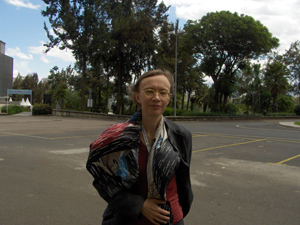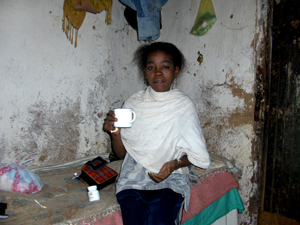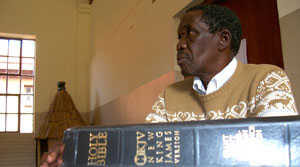Tatiana Shoumilina is an adviser for UNAIDS, the Joint United Nations Program on HIV/AIDS, in Ethiopia. In an interview in May with the International Consortium of Investigative Journalists at the United Nations compound in Addis Ababa, she talked about President’s Emergency Plan for AIDS Relief (PEPFAR), the risk of the United States exporting its methods and solutions to developing countries and the controversy of abstinence-centered programs. Shoumilina, a Russian native, says HIV programs won’t work unless they combine a sense of urgency with long-term planning.
Did Ethiopia arrive late to fight HIV, or later than other countries in Africa?
I am not sure they arrived late. We may talk about intensity of action. It was a bit difficult for this country, because it’s a very religious country. Since HIV was sexually transmitted, it was not easy for them to really recognize that they had a problem. On the other hand, not very many people knew what needed to be done.
We had a very eye-opening experience at one of the woredas (local government area, similar to a district) where we had a team talk in front of us and many of them did not internalize, did not understand what HIV is. It was November of last year. So you have to start not only from basic prevention awareness and internalization, but also go into all this concept of planning and developing action plans. They know that there’s a disease, they know how it’s transmitted, but they don’t know what effect it has when it comes to the community. They never talked about that. They never talked about the complexities involved. So they are taking action, but it’s not going to happen overnight. It’s not an easy undertaking.
The Ethiopian Orthodox Church has become very active in HIV prevention in the past few years. How do they reconcile their religious beliefs with their public health work?
Here the Orthodox Church is saying that the disease is not coming as punishment. Instead they say that the disease comes as a reminder of the need to attract people’s attention to something very important in their lives. They talk about the disease as a means to educate others. It is a very positive view. But it is just not very easy to educate people in this area. When you train the clergy, no matter where, you don’t really know what they know and what they don’t.
It’s risky …
Every institution and every individual that starts working in any field has to go through this transition period in which you accommodate your values and practices to the practices and values of the field you are working in. It is again about communication. The ultimate question is [whether] in the end any institution or organization is going to learn. Is it better not to involve them because they don’t have to have this learning time, or is it better to give them this learning time and then be sure that they are learning? If you don’t involve them, they will be against you because they don’t understand. They can be very dangerous in terms of their actions. I am not referring to any specific organization, it’s a general observation.
How do you convince people against entrenched practices that put them at risk of getting HIV, such as early marriage or female circumcision?
Female circumcision is very well accepted here. It’s cultural. It’s more like, “How can somebody not be circumcised?” There is this issue of external assistance when we come over and we try to assist people using our own concepts and using our own methods. And of course it doesn’t work; you cannot bring an external solution to an internal problem.
Another approach is to let the country and the community deal with the issue. You explain to the community in the language they understand what the issue is. They will deal with that, they know how to deal with that. From what I hear from my colleagues who have worked here for many years … people, locals, usually know the solution, they know how to protect the rest of the community.
Remember our own history, remember the U.S. history and the beginning of HIV. Multiple partners, it was widespread, it was everywhere. [The] sexual revolution brought the multiple partners issues into being … it was there. And it didn’t work when they were saying “Don’t do this.” It did work when they said, “You can continue doing this, but use condoms, use them properly, diminish the number of partners, eliminate the most dangerous practices.” They were talking with people accepting what they do. We cannot say that we are not to accept it [female circumcision], because they have accepted that fully and culturally, it’s up to them to discuss that. This is the only way: We leave them responsibility for protecting themselves.
What do you think about PEPFAR’s emphasis on abstinence and fidelity in its prevention work?
Human beings are complex, holistic. AB works as long as you are also saying, condom use, diminish the number of partners, eliminate the most risky practices. Put it into the range and people will decide for themselves. You can’t decide for them. Take anyone in the developed world and ask if that person would be willing to accept anybody telling him or her what to do. Why do we do to other people something that we don’t accept in relation to ourselves?
Many people here are faithful to their one partner. They say, “I have a wife, why should I be looking for another one?” That’s the notion that we don’t understand. We think that everybody has multiple partners.
If it is our daughter or son … we talk to them about abstinence and fidelity. But if they get into a situation which they cannot control … maybe they fall in love or something else, I don’t know … but if they know that there is another choice, using [a] condom, it’s better if there’s a condom to use. Otherwise we are limiting and we are damaging them. Because if they don’t do what they want to do, they are damaged because they didn’t do it because of external hazard … If they do, then they feel that they are sinful, they have done something that diminishes their value. This is not fair. Options have to be open.
Some faith-based groups believe that talking about condoms to young adolescents will encourage them to have sex.
It can be the case, depending on how you talk about condoms. Everything depends on communication. There are ways to talk about condoms without inducing the idea of sex. If sex is not something that has to be hidden, that has to be taught in secret, if it’s natural, then it becomes part of life and allows youth to make choices for themselves. You can also identify people that are prone to become sexually active and talk to them individually, and probably even influence their behavior and help them postpone the sexual debut. I think that the type of messages and the channel [to youth] can differ, but information has to be available to everybody. You don’t have to talk to them about condoms before you talk to them about other issues, such as body, relationships … and then you can talk in a way that it’s contextually appropriate.
Are there enough programs in Ethiopia that address women and girls?
Programs are always looking at the gender issue; they try to empower women and work with them. I don’t believe this is the right thing to do, because women exist together with men. Then we need to look at the social pressure that is here … on the young boys … the peer pressure, the social pressure. I have a friend who started sexual activity at 16 years old and he said, “I started late.” And that was 20 years ago. You have to look at both men and women, you have to look at the whole picture. You can’t just look at part of it. You have to take care of the women, but you have to take care of the man at the same time.
Can a wealthy donor, for example the U.S. government, shape a country’s policy on HIV/AIDS?
For some time a donor can influence policy, but I don’t think a donor can shape policy. The question is how sustainable this influence is going to be if it is not in line with the country’s cultural tradition … The reason for a donor to come with a certain program and to almost impose it on the national partners is that there’s no common instrument for planning. This is why it’s important to have this common planning [to say], “These are the numbers. These are the channels of distribution. This is how we do it. These are the gaps.”
Is PEPFAR imposing its programs on the national partners?
There’s this contradiction. On the one hand, PEPFAR is trying to be open, with conferences and discussions on how they are doing. On the other hand, all the planning is done internally. And I cannot say that I know much about what PEPFAR is planning to do.
I know the work in the areas of prevention, treatment and care. I know they have signed this agreement with the Global Fund and there’s now this division of responsibilities, which is great. At the same time I don’t feel that the partnership with other actors is the top priority for PEPFAR as an institution. I don’t feel that there’s this action happening to bring different actors together, to be part of a team. It’s not at the individual level; individuals agree. Individuals are trying to be part of the team … they are part of the team. Partnership is when you allow a partner to influence what you do and you listen to your partner.
The other thing that concerns me is this capacity building. In my view, programs have to work so that if the owners are sent out of the country what they have started remains. My judgment in this respect is not an objective judgment, [it] is based on stories that have been told by national partners. They are saying: “They come to the hospital, they arrange everything as they would have arranged it in the United States; they do it the way they do it in the United States.” The national partners do not feel that when PEPFAR finishes what they have done will be there for us; they feel that is more of an imposition.
Those feelings have more to do with PEPFAR’s treatment program than with the prevention program?
Prevention is less tangible; treatment is more tangible. Doctors … feel disposed, they feel that if the programs are run by Americans for Americans in an American way, it isn’t going to last.
Is there a difference between those who run PEPFAR from Washington and those who run it from the field?
PEPFAR is very vertical … People [USAID officials] here are very good …[but] it’s very difficult when you have two different directives … one is from up above and one is from the reality you are facing every day … This is tough for them. We are very sorry, really sorry, to see how difficult it is for them.
Field officers, they have the targets [people in need of services] and they couldn’t even talk [freely]. … They were under attack. They were trying to defend it [the policy], but they couldn’t sincerely defend it because the situation is different. And they could not say that they did not believe in God because the policy is now religious. It’s really tough. You cannot do that. You cannot not do that. And you cannot talk about it.
How do they deal with the pressure?
They try to look for compromise. It’s a common thing. I wouldn’t say that any institution is free of that.
So, how can programs be effective?
The support that international organizations provide is not provided in a manner that can be digested, recycled locally. We are also very controlling; we are trying to make sure that the methodology is used exactly the way we thought it should work.
Here [in Ethiopia] it is a bit different in terms of the notion of it. There’s not a lot of planning because if you can die tomorrow, why should [you] plan for the next year? They have so many problems. Poverty is so impairing in terms of thinking about future. If they don’t work, there’s no future. And since poverty is prevalent here, then there’s no future. They don’t think about the future. They don’t believe in something good happening to them in the future.
PEPFAR is trying to build local capacity, but the way they are building local capacity in some cases it is not the most sustainable way and it is very often not taking into consideration the cultural specificities of the country and it is not using the most appropriate channels of communication. And to be fair, it’s not only them. Many of us are doing the same. They are trying to teach in our own way, which is not right. But we don’t think about that. We don’t know the culture. It’s not intentional.
Some PEPFAR partners said that there’s also this sense of urgency … the need to prevent people from dying … that guide their decisions …
Combining a sense of urgency with long-term judgment, that’s what we need to do. Yes, there is a sense of urgency: “Yes I have helped 15 people today, [but] what about 115 tomorrow? Who is going to help them? What did I do?”
PEPFAR partners say is extremely difficult to launch an ARV [antiretroviral] program in a country that lacks basic health infrastructure …
People don’t access services. They do not go, they don’t trust services. There’s also the issue of distance between the ART [antiretroviral treatment] center and people’s homes. [An]other obstacle is nutrition support: People cannot take drugs because they are hungry. The other is infrastructure … delivery, storage, distribution of drugs. They don’t have doctors, they don’t have trained doctors.
In the end, who owns the ARV program, PEPFAR or the Ethiopian government?
The country owns the ART program, but it doesn’t happen overnight. We are not yet there. The Ethiopian government is trying to bring partners together, but some mechanisms to accomplish that are not being used. It’s difficult; there’s no country that can easily do that. They don’t feel comfortable. They are not very keen to [look at questions of] “How are we going to manage that? Who is going to manage that?”
It’s like I am coming to your house and start building my own bedroom. How do you like that? We could look more often at the institutional arrangements the way we are looking at the human relations. Then many things become very clear. Would I allow this? No. And I wouldn’t allow this at the institutional level if I wouldn’t allow it at the personal level. It’s not easy when you have all these objectives, when you have all these directives and instructions, when you have all this money to spend. It’s not easy to sit and start thinking, “OK, can I allow this?”
PEPFAR has been called by critics “an ideology driven” program. Do you agree?
I think so. Any good, complex program has an ideology behind it. It’s normal. You can’t have a huge program without some ideology, without some idea behind it. How good or how bad the idea is depends on the situation.
How do you see Ethiopia’s future in terms of the fight against HIV?
[It’s] difficult to say because of this political instability, this unclearness. It’s fragile. If the international aid is coming modified or it’s not coming at all, if the World Bank discontinues its support … There’s a great degree of uncertainty.




